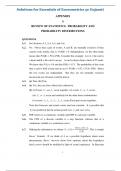Solutions for Essentials of Econometrics 5e Gujarati
APPENDIX
A
REVIEW OF STATISTICS: PROBABILITY AND
PROBABILITY DISTRIBUTIONS
QUESTIONS
A.1. See Sections A.2, A.4, A.5, and A.6.
A.2. No. Notice that a pair of events, A and B, are mutually exclusive if they
cannot occur jointly, that is, P(AB) = 0. Independence, on the other hand,
means that P(AB) = P(A) P(B). Consider this example. Let A = the card is
a heart and B = the card is an ace. A card is drawn from a deck of 52 cards.
We know that P(A) = 1/4 and that P(B) = 1/13. The probability of the event
that a card is both a heart and an ace is P(AB) = 1/52 = P(A) P(B). Hence
the two events are independent. But they are not mutually exclusive
because the ace of hearts could be drawn.
A.3. (a) True, (b) True.
A.4. (a) Yes, they are also collectively exhaustive.
(b) (i) Events E1 and A2 occur together, (ii) events E3 or A3 occur,
(iii) E1 or A1 occur and similarly for the other three combinations;
(iv) events E2 A1 , E3 A2 , E4 A3 occur (Each pair occurs together).
Note that forecasts and actual events need not coincide. It is possible that
E1 was predicted, but the actual growth was A 4 and vice versa.
A.5. PDF relates to a continuous variable and PMF to a discrete variable.
A.6. The CDF of a discrete variable is a step function, whereas that of a
continuous variable is a continuous curve.
P(B| A)P( A)
A.7. Making the substitution, we obtain P( A|B) = . This is simply
P(B)
Bayes’ formula. If we think of A as a possible hypothesis about some
phenomenon, Bayes’ theorem shows how opinions about this hypothesis
held a priori should be modified in light of actual experience. In Bayesian
1
, language, P(A) is known as prior probability and P( A|B) is known as
posterior (or revised) probability.
PROBLEMS
4
A.8. (a) ∑x i −1
= x0 + x + x2 + x3 (Note: x0 = 1).
i =1
6 6
(b) ∑ ay i
= a ∑ y i = a(y 2 + y 3 + y 4 + y 5 + y 6 )
i =2 i =2
2 2 2
(c) ∑(2x i + 3y i ) = 2∑ x i + 3∑ y i = 2(x 1 + x 2 ) + 3(y1 + y 2 )
i =1 i =1 i =1
3 2
(d) ∑∑ x i
y i = x 1 y1 + x 2 y1 + x 3 y1 + x 1 y 2 + x 2 y 2 + x 3 y 2
i =1 j =1
4 4 4
(e) ∑ i + 4 = ∑ i +∑ 4 = (1 + 2 + 3 + 4) + (4)(4) = 26
i =1 i =1 i =1
3
(f) ∑3 i
= 3 + 32 + 33 = 39
i =1
10
(g) ∑ 2 = (2)(10) = 20
i =1
3 3 3
(h) ∑ (4x 2 − 3) = 4 ∑ x 2 − ∑ 3 = 4(12 + 2 2 + 32 ) − (3)(3) = 47
x =1 x =1 x =1
5
A.9. (a) ∑x i
( i from 1 to 5)
i =1
5
(b) ∑i x i
(i from 1 to 5)
i =1
k
(c) ∑(x 2
i
+ y i2 ) (i from 1 to k)
i =1
A.10. (a) [500 (500 + 1)] / 2 = 125,250
100 9
(b) ∑ k − ∑ k = [100 (101)] / 2 – [9 (10)] / 2 = 5,005
1 1
2
, 100
(c) 3∑ k = 3(5,005) = 15,015, using (b) above.
10
A.11. (a) [10 (11)(21)] / 6 = 385
20 9
20(21)(41) 9(10)(19)
(b) ∑ k2 − ∑ k2 = 6
−
6
= 2,585
1 1
19 10
19(20)(39) 10(11)(21)
(c) ∑k − ∑k 2 2
=
6
−
6
= 2,085
1 1
10
(d) 4 ∑ k 2 = 4(385) = 1,540, using (a) above.
1
A.12. (a) Since ∑ f(X ) = 1, (b + 2b + 3b + 4b + 5b) = 15b = 1. Therefore, we
have b = 1/15.
(b) P(X ≤ 2) = 6/15; P(X ≤ 3) = 10/15; P(2≤ X ≤ 3) = 4/15
A.13. (a) Marginal distributions:
X 1 2 3 Y 1 2 3 4
f(X) 0.20 0.40 0.40 f(Y) 0.15 0.10 0.45 0.30
(b) Conditional distributions:
f(X|Y) f(Y|X)
P(X = 1 | Y = 1) = 0..15 = 0.20 P(Y = 1 | X = 1) = 0..20 = 0.15
P(X = 2 | Y = 1) = 0..15 = 0.40 P(Y = 2 | X = 1) = 0..20 = 0.10
P(X = 3 | Y = 1) = 0..15 = 0.40 P(Y = 3 | X = 1) = 0..20 = 0.45
………. P(Y = 4 | X = 1) = 0..20 = 0.30
………. ……….
The remaining conditional distributions can be derived similarly.
A.14. Let B represent the event that a person reads the Wall Street Journal and let
3
, A1, A2, and A3 denote, respectively, the events a Democrat, a Republican,
and an Independent. We want to find out P(A2 |B) :
P(B| A2 )P(A2 )
P(A2 |B) =
P(B| A2 )P(A2 ) + P(B| A1 )P(A1 ) + P(B| A3 )P(A3 )
(0.6)(0.4)
= = 0.558
(0.6)(0.4) + (0.3)(0.5) + (0.4)(0.1)
Note that the prior probability of sampling a Republican is 0.4 or 40%. But
knowing that someone is found reading the Wall Street Journal, the
probability of sampling a Republican increases to 0.558 or 55.8%. This
makes sense, for it has been observed that proportionately more
Republicans than Democrats or Independents read the Journal. This
example is an illustration of Bayes’ Theorem.
A.15. This is P ( A + B ) or P(A ∪ B) = 0.9.
A.16. (a) No, for the probability that this happens is 0.2 and not zero.
(b) Let A denote having children and B denote work outside home. If these
two events are to be independent, we must have P(AB) = P(A) P(B). In the
present case, P(AB) = 0.2 and P(A) = 0.5 and P(B) = 0.6. Since in this case
P(AB) ≠ P(A) P(B), the two events are not independent.
A.17. From Table A-9, it can be seen that
X� Below poverty Above poverty f(Y) �
Y�
White 0.0546 0.6153 0.6699
Black 0.0315 0.0969 0.1284
Hispanic 0.0337 0.1228 0.1565
Asian 0.0046 0.0406 0.0452
f(X) � 0.1244 0.8756 1.00
4







